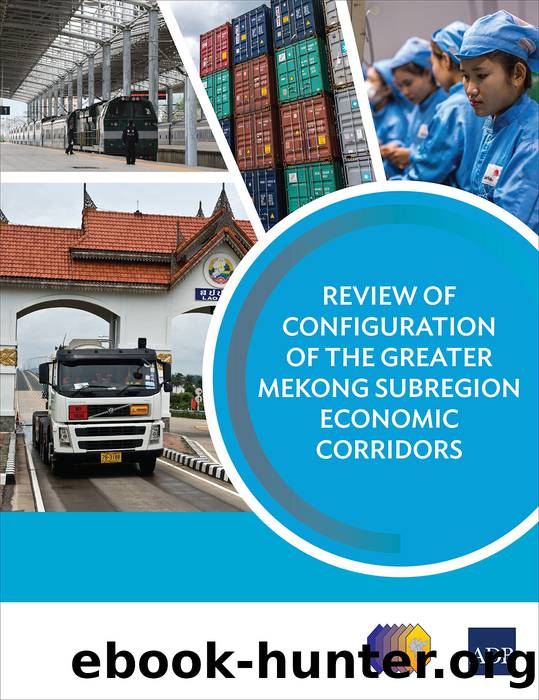Review of Configuration of the Greater Mekong Subregion Economic Corridors by Asian Development Bank;

Author:Asian Development Bank;
Language: eng
Format: epub
Publisher: Asian Development Bank Institute
Published: 2018-08-15T00:00:00+00:00
B. Criteria for Realignment and/or Extension
In reviewing the configuration of EWEC, NSEC, and SEC, the primary concern is to ensure that: (i) developments arising from the opening up of Myanmar are taken into account; (ii) corridors include and link all GMS capitals and major economic centers; (iii) corridors are connected to key GMS maritime gateways and industrial hubs; and (iv) major trade flows are reflected in the alignment of the corridors.
Viewed from these requisites, the following glaring gaps need to be addressed by extending and/or realigning the economic corridors:
â¢There is relatively limited involvement of the Lao PDR and Myanmar in EWEC and NSEC.
â¢Yangon, Nay Pyi Taw, and Vientiane are not included in any economic corridor.
â¢Yangon Port is not linked to any economic corridor.
â¢The principal cross-border trade routes between the PRC and Myanmar; Myanmar and Thailand; and the PRC, the Lao PDR, and Thailand are not reflected in the alignment of the economic corridors.
Figure 3 illustrates the limited coverage of the economic corridors in the Lao PDR and Myanmar. This is also evident in Figure 5, which shows the intercountry distribution of EWEC, NSEC, and SEC in terms of the estimated country-wise length of the economic corridors as a percentage of the total length of the corridors. Only 12%â14% of the lengths of EWEC, NSEC, and SEC are in Myanmar, and a similar percentage of the lengths of EWEC and NSEC are in the Lao PDR. Myanmar was actually not part of the SEC before the inclusion of Dawei in 2011. As regards the primary trade routes cited above, only three are part of EWEC, NSEC, and SEC (KunmingâBangkok via Lao PDR, BangkokâPhnom PenhâHo Chi Minh City, and KunmingâHa NoiâHai Phong). The other three (BangkokâVientiane, BangkokâYangon via Mae SotâMyawaddy, and KunmingâMandalay via MuseâRuili) are not included in any of the economic corridors.
Figure 5: Intercountry Distribution of the Greater Mekong Subregion Economic Corridors (%)
Download
This site does not store any files on its server. We only index and link to content provided by other sites. Please contact the content providers to delete copyright contents if any and email us, we'll remove relevant links or contents immediately.
The Vikings: Conquering England, France, and Ireland by Wernick Robert(79222)
Ali Pasha, Lion of Ioannina by Eugenia Russell & Eugenia Russell(39939)
The Vikings: Discoverers of a New World by Wernick Robert(36830)
The Conquerors (The Winning of America Series Book 3) by Eckert Allan W(36715)
Cecilia; Or, Memoirs of an Heiress — Volume 1 by Fanny Burney(32093)
Cecilia; Or, Memoirs of an Heiress — Volume 3 by Fanny Burney(31481)
Cecilia; Or, Memoirs of an Heiress — Volume 2 by Fanny Burney(31435)
Empire of the Sikhs by Patwant Singh(22779)
Hans Sturm: A Soldier's Odyssey on the Eastern Front by Gordon Williamson(18341)
The Secret History by Donna Tartt(18267)
Cat's cradle by Kurt Vonnegut(14804)
Sapiens: A Brief History of Humankind by Yuval Noah Harari(14006)
Pimp by Iceberg Slim(13828)
Talking to Strangers by Malcolm Gladwell(12916)
Norse Mythology by Gaiman Neil(12879)
Leonardo da Vinci by Walter Isaacson(12833)
Underground: A Human History of the Worlds Beneath Our Feet by Will Hunt(11857)
4 3 2 1: A Novel by Paul Auster(11843)
The Radium Girls by Kate Moore(11651)
